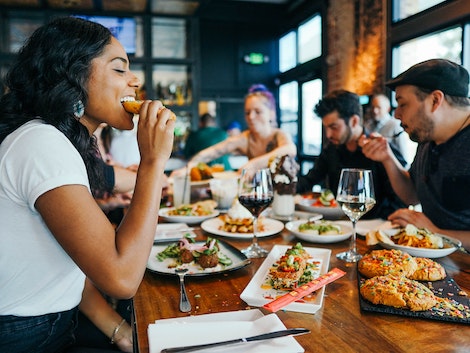

 Diners enjoy small plates in a restaurant in Florida
Diners enjoy small plates in a restaurant in Florida With the pandemic receding across the land, Americans are, more than ever, into sharing. This is good news for the Spanish wine world, as small plates and by-the-glass offerings continue their pre-Covid ascendency.
It’s especially good news for smaller Spanish wineries, many of which virtually disappeared during a 15-month stretch when consumers gravitated toward familiar brands.
“Buyers have not lost their desire to support and promote smaller wineries,” says Andy Myers, wine director for Jose Andres’ ThinkFoodGroup, whose national portfolio includes 28 mostly Spanish-themed restaurants. “If anything, our restaurant group, and those like us, are more excited than ever to support the independent growers and wineries. They have suffered and persevered right alongside the restaurant community … we are more committed than ever to be great partners to the small wineries.”
Three factors have boosted the renaissance of smaller operations:
- The Biden administration’s lifting of onerous tariffs in March made Spanish wine prices cheaper.
- Restaurants’ wine programs skew much more heavily toward by-the-glass (BTG) options than even a few years ago.
- And an emerging younger generation is much more geared toward experimenting (and much less brand-loyal) than their elders.
“As with small plates, BTG gives customers a chance to try more things,” says Minneapolis-based restaurant consultant Tobie Nidetz. “Instead of a $70 Rioja they’ve never tasted, they can try and share.”
Myers adds: “I suspect that BTG will get a little boost as people are looking to expand their palates and experiences after a year-plus of being stuck with a fair amount of the same old, same old.”
As Nidetz notes, single glasses and tapas could not be more complementary.
“I think the idea of small plates and sharing with others has a renewed excitement,” Myers says, “and that we will absolutely see people gravitating to the shared fun and camaraderie that comes from small-plate dining.”
Americans’ ardent aspirations for restaurant experiences will be tempered by the old supply-and-demand law. Since the pandemic began, 10.2% of US food establishments have closed permanently, according to the food-and-beverage research group Datassential. Other estimates are higher, but in any case it will be a long while (if ever) before the number of US restaurants reaches pre-Covid levels.
And that landscape will be different in many ways. Eateries from Zuni Cafe in San Francisco to Augustine in St. Paul, Minn., have implemented pay-equity measures that include no tipping —with a service charge replacing it. Meanwhile, self-service is on the rise, with the effects on wine yet to be determined.
The curbside service that emerged over the last year-plus isn’t going away, with 35% of off-premise customers saying they would be more likely to choose a restaurant if they can get an adult beverage, according to the National Restaurant Association’s 2021 State of the Restaurant Industry Report.
Neditz foresees smaller portions and/or increased prices at restaurants that were making little to no margins on food and relied almost completely on profits from beverages. The Restaurant Association’s report predicts that 63% of fine-dining and 53% of casual-dining establishments will cut menu items.
Many establishments already have or will reduce the number of wines they offer, but primarily to make ordering easier and more streamlined for consumers. But they need wine and other alcoholic beverages as much as ever, after seeing revenues fall by $240 billion last year. The association predicts that full-service operations (dine-in and take-out), down 30% in 2020, will have a 6.7% rise this year.
That cannot happen too soon, and restaurant operators know it. Many still have fewer tables because of social-distancing measures, but more of these tables have larger groups than before — larger and more enthusiastic, fulfilling one of the Restaurant Association’s forecasts: “As the vaccine rollout becomes more widespread … [and] as local economies reopen and restrictions are eased, consumers will be poised to burn off the accumulated pent-up demand for restaurants."
And Spain’s food-friendly wines are poised to take full advantage. “Spanish wine,” Myers says, “is fun, vibrant, dynamic and offers so many fantastic opportunities to explore and discover that I think it will continue to delight and fascinate guests.”